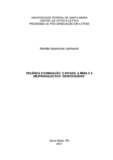| dc.creator | Lachovski, Marilda Aparecida | |
| dc.date.accessioned | 2021-11-17T13:23:25Z | |
| dc.date.available | 2021-11-17T13:23:25Z | |
| dc.date.issued | 2021-05-25 | |
| dc.identifier.uri | http://repositorio.ufsm.br/handle/1/22829 | |
| dc.description.abstract | The present thesis work, anchored in the perspective of Discourse Analysis, proposes a reflection on the discursivization of violence practices, in and by the media, in a relationship with the State and legal norms. Among the practices of violence, lynching is understood as one of the ways in which “doing justice” is reproduced, and also as a possible place of confrontation, attesting to the attempt to naturalize violence, under the existence and organization of the street’ courts of justice. Through interdiscourse, slavery resonates, legitimizing symbolic violence as an instrument for the efficiency of a regulatory and punitive power, on the one hand for the false tutelage of the State and, on the other, for the population in a pretext of justice, producing the incitement to hatred against certain subjects and social groups. We ask ourselves about the ways in which these street courts are organized, in and by discourse, in and by the media, asking for the devices that regulate these collective organizations, and how they make the modes of domination and exclusion work, ideologically inscribed in the construction of an ideal of nation and citizenship. To this end, we selected five discursive clippings: three cases of lynching that circulated in the media and two series of comments by subjects users/followers of the pages of newspapers Extra and G1, on Facebook, about these cases, in which regularization and repetition produce movements of meanings on “doing justice”, on justifying. Regulation and control, as justifications for lynching, work as part of the domination process, in which skin color and lace are still, as effects of naturalization, what defines, legitimizes and sustains symbolic violence. It is the functioning of the modes of domination and exclusion that affect and cross legal practices in Brazil, (re)producing the emerging portion of “dispossessed” subjects, structuring the social division. | eng |
| dc.description.sponsorship | Coordenação de Aperfeiçoamento de Pessoal de Nível Superior - CAPES | por |
| dc.language | por | por |
| dc.publisher | Universidade Federal de Santa Maria | por |
| dc.rights | Attribution-NonCommercial-NoDerivatives 4.0 International | * |
| dc.rights.uri | http://creativecommons.org/licenses/by-nc-nd/4.0/ | * |
| dc.subject | Discurso | por |
| dc.subject | Mídia | por |
| dc.subject | Linchamento | por |
| dc.subject | Violência simbólica | por |
| dc.subject | Discourse | eng |
| dc.subject | Media | eng |
| dc.subject | Lynching | eng |
| dc.subject | Symbolic violence | eng |
| dc.title | Violência e dominação: o estado, a mídia e a (re)produção dos “despossuídos” | por |
| dc.title.alternative | Violence and domination: the state, the media and the (re) production of the “dispossessed” | eng |
| dc.type | Tese | por |
| dc.description.resumo | O presente trabalho de tese, ancorado na perspectiva da Análise de Discurso, propõe uma reflexão sobre a discursivização das práticas de violência, na e pela mídia, numa relação com o Estado e normas jurídicas. Entre as práticas de violência, o linchamento é entendido como uma das formas em que se reproduz o “fazer justiça”, e também como um possível lugar de confronto, atestando para a tentativa de naturalização da violência, sob a existência e organização dos tribunais de rua. Pelo interdiscurso, a escravidão ressoa, legitimando a violência simbólica como instrumento para a eficiência de um poder regulador e punitivo, por um lado pela falsa tutela do Estado e, por outro, pela população num pretexto de justiça, produzindo a incitação ao ódio contra determinados sujeitos e grupos sociais. Questionamo-nos sobre os modos como se organizam esses tribunais de rua, no e pelo discurso, na e pela mídia, perguntando pelos dispositivos que regulam essas organizações coletivas, e como essas fazem funcionar os modos de dominação e exclusão, ideologicamente inscritos na construção de um ideário de nação e de cidadania. Para tanto, selecionamos cinco recortes discursivos: três casos de linchamento que circularam na mídia e duas séries de comentários de sujeitos usuários/seguidores das páginas dos jornais Extra e G1, no Facebook, sobre esses casos, nos quais, a regularização e a repetição produzem movimentos de sentidos sobre o “fazer justiça”, do justiçar. A regulação e o controle, como justificativas para o linchamento, funcionam como parte do processo de dominação, no qual a cor da pele e a renda ainda são, como efeitos de uma naturalização, aquilo que define, legitima e sustenta a violência simbólica. É o funcionamento dos modos de dominação e exclusão que afetam e atravessam as práticas jurídicas no Brasil, (re)produzindo a emergente parcela de sujeitos “despossuídos”, estruturando a divisão social. | por |
| dc.contributor.advisor1 | Scherer, Amanda Eloina | |
| dc.contributor.advisor1Lattes | http://lattes.cnpq.br/0683532681929143 | por |
| dc.contributor.referee1 | Venturini, Maria Cleci | |
| dc.contributor.referee2 | Coutinho, Renata Patricia Corrêa | |
| dc.contributor.referee3 | Lisowski, Carolina Salbego | |
| dc.contributor.referee4 | Medeiros, Caciane Souza de | |
| dc.creator.Lattes | http://lattes.cnpq.br/4369257971293674 | por |
| dc.publisher.country | Brasil | por |
| dc.publisher.department | Letras | por |
| dc.publisher.initials | UFSM | por |
| dc.publisher.program | Programa de Pós-Graduação em Letras | por |
| dc.subject.cnpq | CNPQ::LINGUISTICA, LETRAS E ARTES::LETRAS | por |
| dc.publisher.unidade | Centro de Artes e Letras | por |



